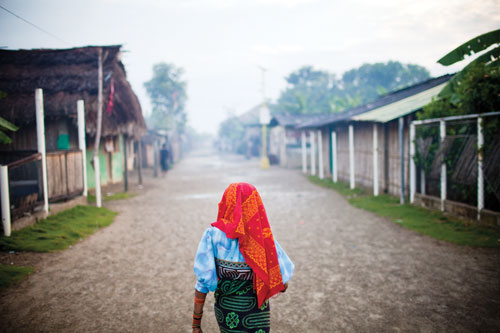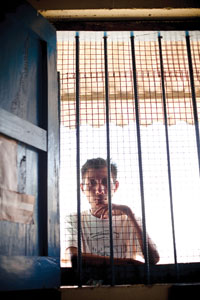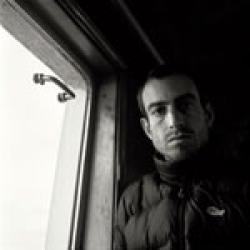As sea levels climb, the elders of Kuna Yala fear they may be flooded out of their ancestral home
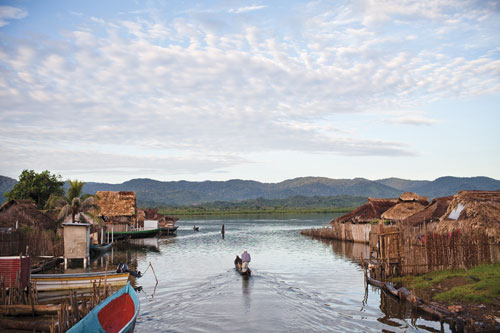
- A villager heads out to fish in his cayuco, or dugout canoe, soon after sunrise in the Kuna island village of Usdup. Situated along the northeastern coast of Panama, the village is one of the inhabited islands of Kuna Yala that are increasingly flooding due to rising sea levels.
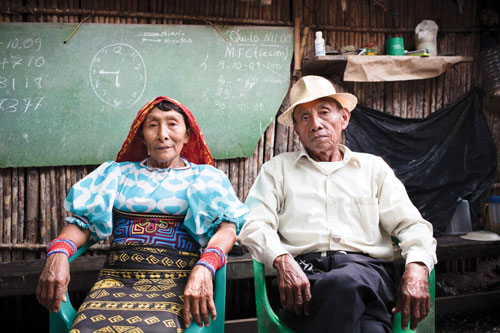
- The chief village elder, or sahila, in Usdup, Leodomiro Paredes (shown here with his wife, Imelda) is leading discussions in his community about the possibility of relocating the entire village to the Kuna’s mainland forest.

- As the dirt paths slowly dry after a rainy season storm, a young Kuna student poses for a portrait on his way home from school.
The sahilas, or wise elders of Kuna Yala, will swing in their hammocks after dinner when the moon rises at night. There, within walking distance from the sea and under an enormous thatched roof hut, they’ll recite Pab’igala, the metaphorical songs of Kuna culture that explain the sacredness of the Earth. Most Pab’igala are poetic adages about nature. One song says that the Kuna’s islands (365 of them, one for every day of the year, they say, dotting the Caribbean) are like “coconuts resting firmly on the sand”; they will never disappear, regardless of the strong winds and the high tides.
But more recently, a less optimistic Pab’igala has been sung. “Why are our mothers crying? It is because of the hurricanes and earthquakes,” go the lyrics. “Times are getting dark. Who is causing this?”
That Pab’igala was first sung after giant waves flooded a majority of Kuna islands in October 2008. The storm surge, which lasted almost two weeks, ruined homes and schools, glutted subsistence crops. When the floodwaters receded, residents went back to their slow and traditional ways of life: fishing in the sea before sunrise, harvesting plantains and coconuts on the mainland, attending the nightly congresos, or town hall meetings. But the episode had a more lasting impact, one that would force the elders to think about what had once been unthinkable. They now feared they would be flooded out of the islands they’ve called home for several hundred years. The only other land where they could conceivably relocate their population of forty-five thousand was their sacred mainland forest—but doing so would test strong taboos.
On a cool autumn morning exactly one year after the floods, we boarded a twenty-seat prop jet in Panama City and headed to Usdup, one of the smallest but most populous of the Kuna islands. After a turbulent forty-five minute ride through the clouds, we saw the fog recede through lush mountain valleys as the sun peeked over the horizon. In the distance, we could spot a cluster of tiny islands, and some larger ones, too, seemingly uninhabited. We disembarked on the island’s airstrip and watched the plane take off for another island.
“Do you know where you’re staying?” asked Toyo, a young and stocky man who worked for the airline. Our plans to stay at a local teacher’s home had fallen through at the last minute, so Toyo climbed with us inside a cayuco, or dugout canoe, and kindly took us halfway around Usdup to the only hotel in the village, located directly across the bay from the dense mainland forest.
Usdup has a population of about five thousand people. As we walked through its mazelike footpaths—the authorities ban cars and motorcycles on the island and do without signs or addresses—it was easy to get a sense of how tightly packed it really was. Children played in groups all around us; women were more likely to be indoors, within the network of huts and courtyards, cooking, caring for their babies, and embroidering molas—the traditional fabrics of intricate and colorful patterns that have drawn anthropologists here for years. If the men weren’t at home swinging in their hammocks or going to the congreso, they could be seen in the early morning hours, headed out to sea to fish or to the mountains in search of food.
“Everyone here makes a living from nature, and each family has a small parcel on the mainland where they can grow coconuts, manioc, cocoa, yucca, corn, and bananas,” said Toyo, a pile of green coconuts behind him. “I’ve lost the custom of heading out each morning to harvest, but when I was a kid, I would always go in the cayuco to help my father.”
As he spoke, Toyo’s kids and neighbors sat inside their house, facing an old TV set (one of only about a dozen in town), watching Spanish- dubbed cartoons. They too were losing their Kuna ways, Toyo said, with some shame. But despite a few modern-day distractions and comforts like cell phones, most residents still live simple and traditional lives. Their days, shaped by their proximity to the sea, are spent closely in tune with nature and its cycles—the ebb and flow of tides, the seasons of fishing and crops.
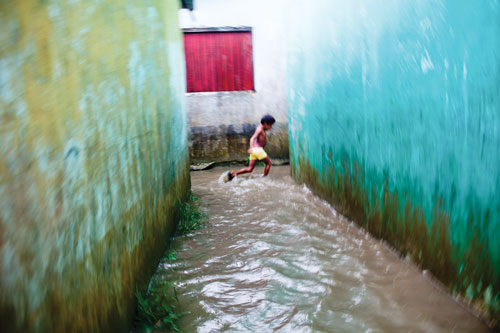
- A child runs through a rush of water flowing between buildings after a downpour. The Kuna say that storms are stronger now, causing their villages to often flood. A storm surge in 2008, which lasted almost two weeks, ruined schools, subsistence crops, and many wood and straw homes.
The Kuna living on the forty-eight inhabited islands will likely have to move to the mainland within a generation if they want to secure their culture, religion, environment, economy, and history. “But can you imagine how difficult that would be?” Toyo asked.
Over the past decade, however, the bonigana or Kuna forest, and their islands, have come under serious threat from climate change. Recent studies by the Smithsonian Tropical Research Institute show that since 1910, the average sea level in Kuna Yala has risen by almost six inches, and it’s now increasing by around three-quarters of an inch each year. The islands don’t rise much above sea level, and it isn’t difficult to guess how many years it would take before they are underwater if the trend continues unabated. In the meantime, many island communities have had to resort to using landfill made of gravel from the beds of nearby rivers to keep the sea at bay. With climate change, researchers say there will not only be the rising sea level to contend with, but also an increased risk of diseases, such as malaria and dengue fever; greater incidence of drought followed by more extreme storms, hurricanes, and flooding; and changes to the biodiversity on which the Kuna stake their livelihoods and survival.
The Kuna living on the forty-eight inhabited islands will likely have to move to the mainland within a generation if they want to secure their culture, religion, environment, economy, and history. “Many experts have come to Kuna Yala to study our situation and suggest that we move to the mainland, and into the forest,” Toyo told us one day, as we stood on the edge of the island facing a row of mangroves. “But can you imagine how difficult that would be? And how would we pay for it?”
Despite its natural riches, the Kuna communities are cash poor and unable to pay for the equipment or labor necessary to cut down trees and build roads and other infrastructure. The Panamanian government has talked about helping the communities with the transition in the next ten to fifteen years, but the nature of this help, much less its cost, hasn’t been defined.
Kuna Yala is unique among indigenous communities in Panama. After a violent rebellion against state forces in 1925, calls for sovereignty and extensive negotiations with Panama’s central government brought the autonomous Comarca of Kuna Yala into being in 1938. The new status enabled its people to implement a unique system in which they maintained their own self-governance while gaining full voting rights in Panama. The Kuna General Congress, their highest government body, is represented at Panamanian government level by three general caciques, or chiefs. The Congress sits twice a year with five delegates from each of the forty-eight communities in the comarca, which meet on a nightly basis to debate issues and vote on them. Almost eighty-five years later, this inclusive and participatory form of government gives the Kuna one of the greatest degrees of self-rule of any indigenous group in Latin America.
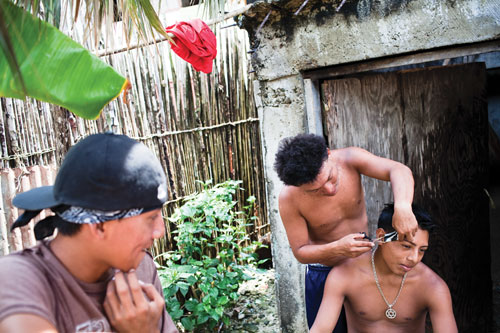
- Outside cultural influences on Kuna youth have made it difficult for village elders to convince the newer generations to stay in Kuna Yala, instead of migrating to Panama City. But Kuna leadership is even more concerned these days that a forced relocation from the Kuna’s islands will cause many of their traditions to be lost.
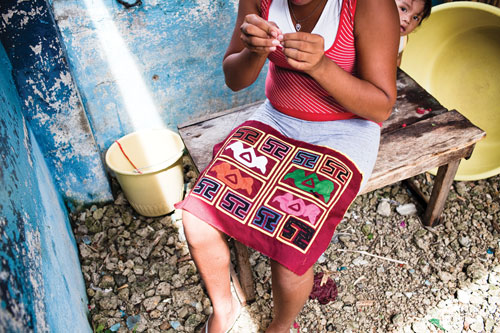
- The mola is the most well-known of the Kuna’s crafts. Still part of women’s traditional dress, the elaborately decorated fabric is also popular with tourists visiting Panama.

- A portrait of Kuna independence hero, Nele Kantule, hangs over the Usdup village meeting hall, or congreso. In addition to living on an archipelago that can only be reached by air or sea, the Kuna have been able to preserve their traditions due in large part to the sovereignty they won from the Panamanian state after a rebellion in 1925.
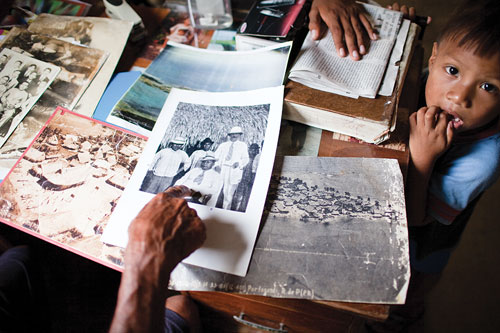
- Kuna elder, Jesus Smith Sr., points to a photo of his grandfather, the leader of the Kuna’s 1925 rebellion, Nele Kantule. Kantule’s fighting spirit persists among the Kuna today, and many promise that they will fight to have a say in determining the future of their island homes.
“Other indigenous groups around the world have fought very hard to keep their land and their traditions, but haven’t been as successful as we have,” said Toyo’s friend, Feliciano Jones, a wise and gentle seventy-year-old man who told us that, in his younger years, did construction work on the Panama Canal. “We come from a tradition where the cacique often reminds us: ‘Who said we are tired of being indians? We will only stop being indians when our God calls us to go join him up above.’”
Toyo and Feliciano would spend a lot of their time sitting outside, under the palm trees, playing dominoes and talking politics. Over and over again, Feliciano would recite the events of 1925 when our conversation turned towards the future. “If our territory came under threat, for any reason, I would take up arms to defend it,” he once told us, shaking his fist in the air. “The main thing we share as Kuna, is that we don’t take for granted what our ancestors did for us.”
A reincarnation of this revolutionary spirit is evidenced by Kuna resistance to outside influences over their territory. Over the last thirty years, the sahilas have been successfully fighting infrastructure projects that threaten their rights over their land and forests—from governmentgranted mining concessions to plans for a major highway. Two years ago, they successfully challenged the state’s effort to run an electricity power line through their territory. But most recently, they’ve been debating their stance on a controversial effort by the United Nations and the World Bank, which would use forests like the Kuna’s as a carbon offset for major polluters in the industrialized world. Along with the Pab’igalas, the Kuna’s political leaders are talking about the increasingly severe rising seas and floods; while there is no Kuna word for climate change, the Spanish “cambio climático” can be heard often in their discussions about their unpredictable future.
On our last evening in Usdup, at sundown, Feliciano and Toyo met us inside the cavernous congreso hall. Dozens of people, most of them middle-aged men, sat around on aged and handcrafted wooden benches facing a large portrait of Kuna independence hero, Nele Kantule. Below the painting, each of the three sahilas sat on a hammock with eyes closed, singing Pab’igalas on a loop, much like a mantra.
“Do you know why the bird raises its head towards the sun each time he swallows?” whispered Toyo softly in my ear, as he began to translate one of the sahila’s words. “Because he’s thanking Bab Tummat for giving him food and drink,” he said, invoking the name of the Kuna’s creator deity. “The Kuna should learn from the bird, and be humble, and thank Bab Tummat for our food and water each day.”
“I like that,” said Toyo, nodding to me in approval. Feliciano sat next to him, with eyes closed, drifting off to sleep. We sat inside the congreso for close to two hours, lost in the sahilas’ hypnotic, circular chants and their predictions for the future. The sky grew dark and heavy, and another tropical downpour began, lightning followed by menacing thunder. Outside, the dirt paths quickly turned to mud, then soon started to flood; and we could make out the noise of children running and splashing around, looking for cover.
This story was produced in association with the media NGO Project Word as part of coverage of a UN climate mitigation program in Panama and made possible by a grant from the Christensen Fund.






